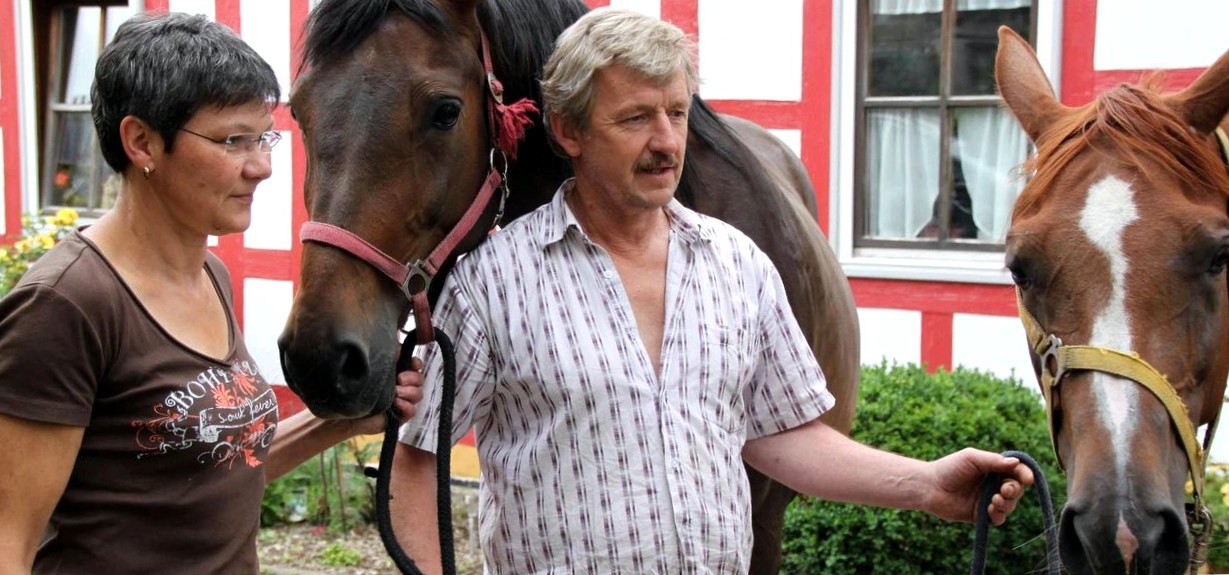
The cow is visibly happy. She is lying there in the shade – completely relaxed – and dozing away. "We have a resting area for our animals here, where they like to retreat", says farmer hans-georg warmuth. Almost like in a hotel. "And even with full board."
Because the calves, cows and horses on the farm of the warmuths also get food of course. But first the hay must be harvested. This always happens in the middle of june – at least when the weather plays along. "We are very dependent on the weather", says district farmer marion warmuth "if it doesn't rain in the spring, the grass grows poorly. If it is not sunny in summer, the hay does not dry out. And if it rains constantly in the summer, the hay becomes damp and mouldy." So some things have to fit.
A farmer needs three sunny days in a row if he wants to harvest his hay. First the grass is cut, then spread on the meadow – so that it dries faster. It remains there for the next two days. Once or twice a day the farmer comes and turns the hay.
"The time of harvesting is very important, because depending on it the ingredients of the hay change", explains warmuth. While young grass is very high in protein, old grass contains more fiber and is therefore easier to digest.
Sometimes, however, nature conservation dictates the time of harvesting. There are, for example, grassland breeders such as the lapwing, which are literally dependent on the meadow. "We will of course take this into consideration. Such meadows are mowed only later", says warmuth.
In this context, the district farmer also points out that meadows are not free areas where everyone is allowed to let off steam with their dog. "Fields and meadows are private property – many people are not aware of this", says marion warmuth. Dog excrement often remains on the fields and thus gets into the feed of the animals. "This is harmful and can lead to diseases." Since the dog is a carnivore, it excretes certain parasites that the herbivore's defenses can't handle. Farmers also often have problems with unseasonal hay. "People walk on the field paths and simply throw their mull onto the meadow. That's not possible", says warmuth.
Machines replace manual labor
But back to the hay: after two days, everything is dry, then the hay is straightened into long strips again. The round baler then ensures that the hay is formed into the practical bale shape and held together with a net. One bale weighs 300 to 400 kilograms. "There's not much you can do with your hand", says hans-georg warmuth. That's why everything is done by machine: the front loader splits the bales and loads them onto the hanger, which takes the hay to a shed for storage. It remains there for another four weeks. Only then can it be fed.
Animals are used to hay
The hay is especially important for the calves, because it introduces them slowly to solid food. Hay is not as difficult to digest as silage and so the rumen of young animals can slowly change from milk to hay. But not only calves like to eat the hay, it is also basic fodder for horses.
In addition to dairy cattle, 18 horses also live on the warmuths' farm, seven of which come from the farm's own breeding program. "In the past, every farm had horses as working animals, but then they were replaced by tractors", says warmuth. They had their horses, however, "as a hobby, as she says, retain.
The passion for horses has remained, and so the keeping has developed into a breed. Today, the warmuth family is one of the last horse breeders in the region and is also a member of the franken horse breeding association.